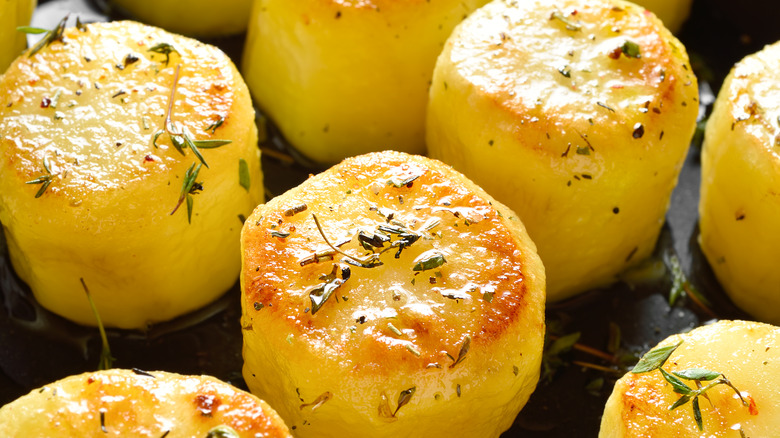Gordon Ramsay's Tip For Superb Fondant Potatoes
Love him or hate him, one thing that is nearly unanimously agreed upon is that Gordon Ramsay knows how to cook. One doesn't rise to his level of fame in the culinary world without talent, as evidenced by his eponymous restaurant — Restaurant Gordon Ramsay (RGR) — which garnered three highly-coveted Michelin stars within four years of opening.
Ramsay began his career working in the kitchens of famed chefs Marco Pierre White and the Roux brothers, notes MasterClass. It was there that he was steeped in the recipes and techniques of French haute cuisine, a style that still largely informs his cooking today, explains RGR's website. As such, it's no surprise that he has some masterful takes on classic French recipes, from Beef Bourguignon with Celeriac Mash and Spaghetti with Seafood Velouté to Strawberry and White Chocolate Millefeuille and Pear Tarte Tatin (via BBC Good Food.)
In the pantheon of French cuisine, there is no shortage of recipes for preparing potatoes – aka "pommes de terre." The blog Snippets of Paris compiled a list of some of the most well known, which includes gratin dauphinois, frites, and pommes aligot. Another classic is fondant potatoes, a dish that sounds simple enough to prepare, but can fall apart upon execution if certain considerations aren't made.
Given his background, Ramsay has some tips for fondant potatoes that will help chefs of any skill level master this savory, satisfying spud style every time.
The trick to making fondant potatoes tender and tasty
As reported by The Guardian, Ramsay's chief piece of advice when attempting fondant potatoes, "pommes fondantes" which means "melting potatoes" in French, is to pick the right potato. He suggests a "robust" potato like a Desirée potato, which Specialty Produce notes has both waxy and floury qualities, or a King Edward potato, which cooks up fluffy.
How the potatoes are prepped is also important. As the first step toward fondant potatoes is a hot sear to caramelize, Ramsay recommends simply halving the potatoes in order to maximize the surface area and depth of flavor. Speaking of that sear, while many fats are acceptable, from duck fat to butter, Ramsay reaches for olive oil and adds just a touch of butter to finish the dish. Once the searing session is complete, he gives the potatoes a bath in flavorful chicken stock before finishing them in a hot oven (via YouTube.)
As noted above, the fat for fondant potatoes can vary, but its role cannot be overstated. It is one of the most important elements of the dish because of the ability fats have to render foods tender while keeping them from getting overburdened with moisture. No one should mistake fondant potatoes for a low-calorie dish and chefs shouldn't be off-put by the amount of fat they need to use to create a truly memorable side.

